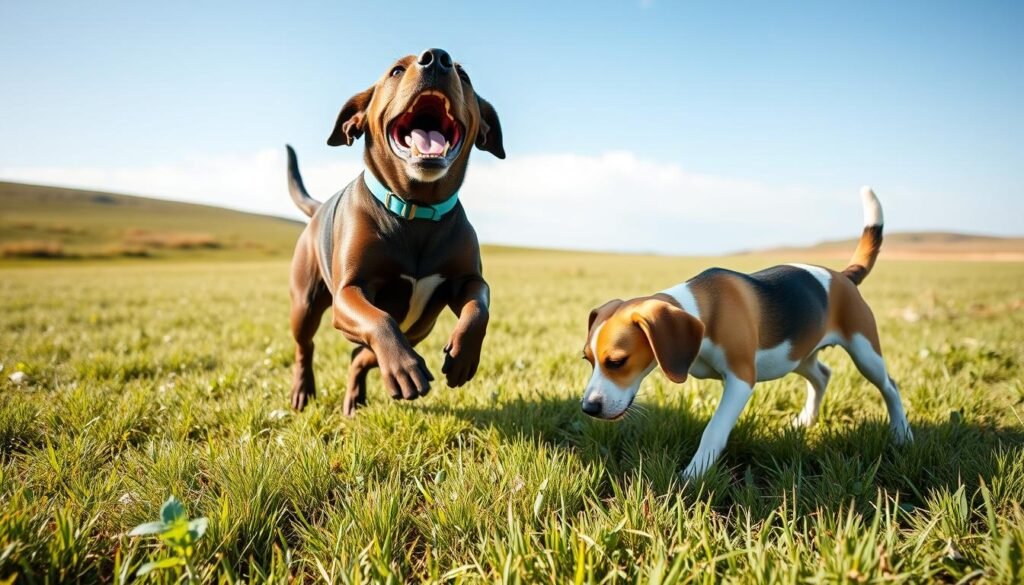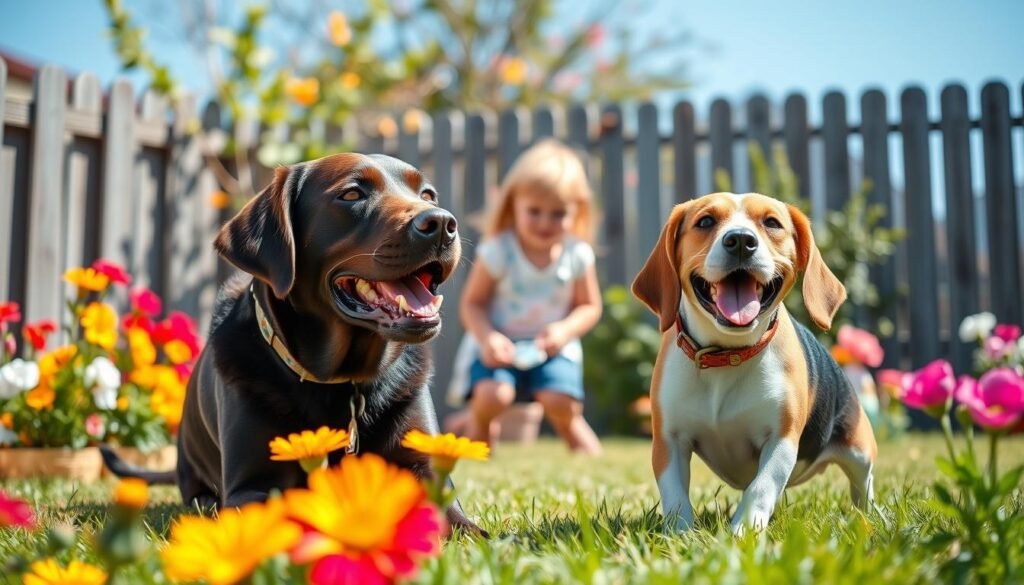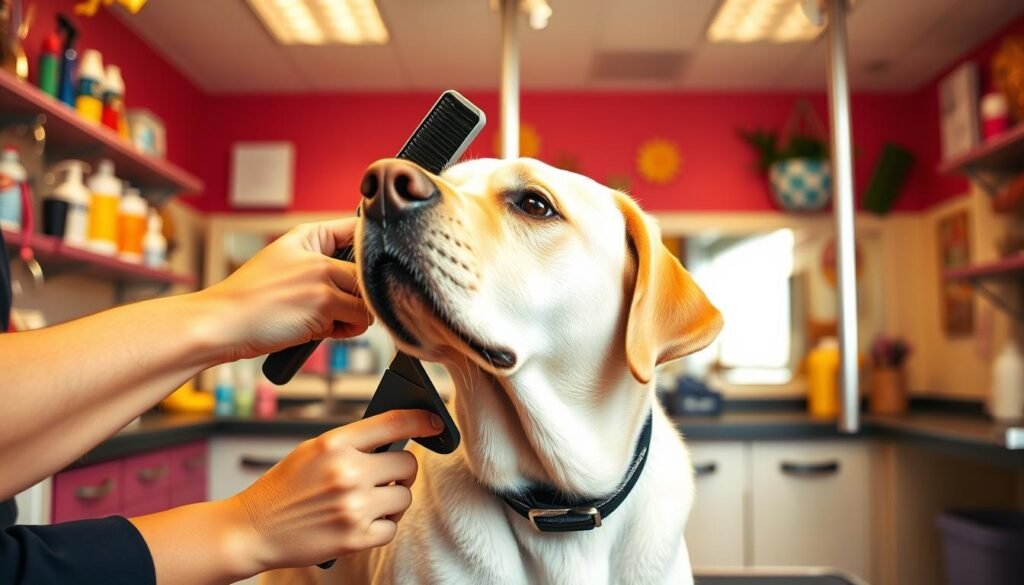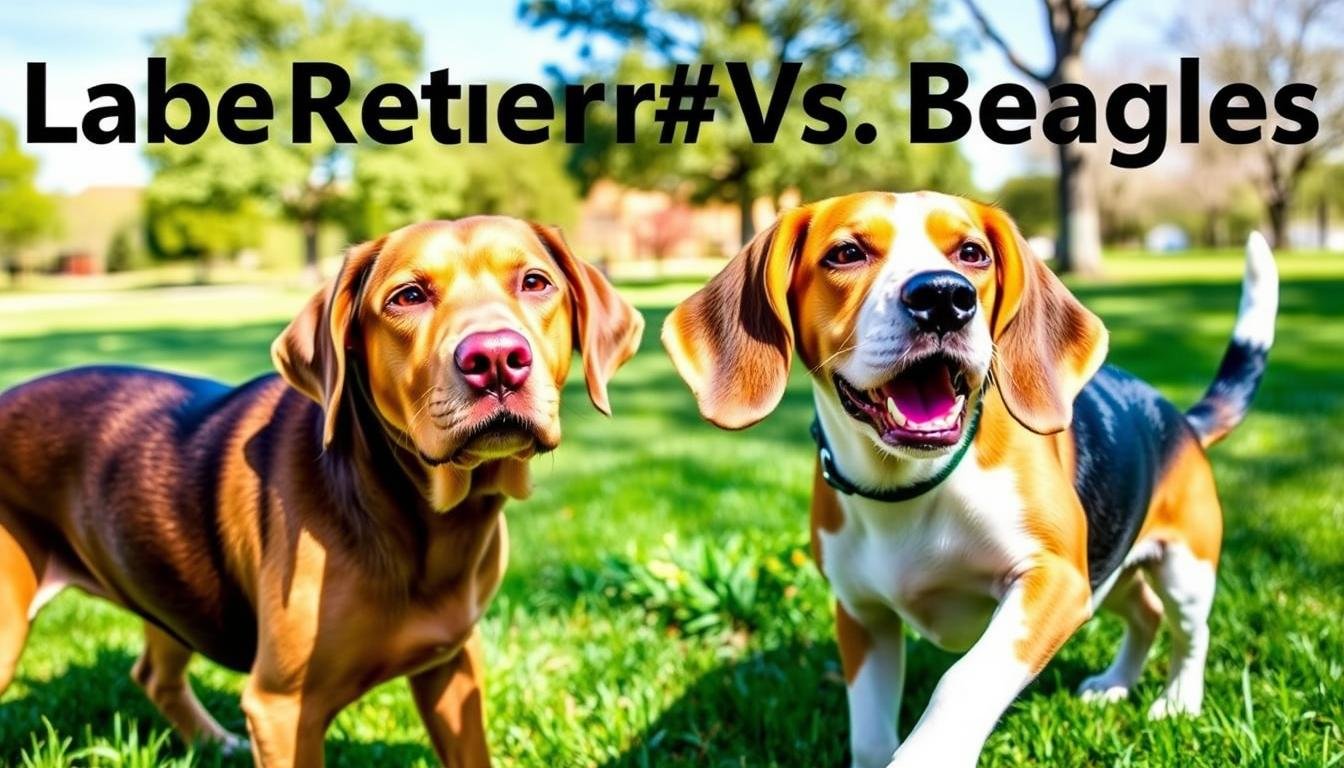Labrador Retrievers vs Beagles: Which Breed to Choose
Did you know Labrador Retrievers have been America’s favorite dog for 31 years? This fact highlights our comparison of two popular family dogs: Labrador Retrievers and Beagles. While Labs are the top choice, Beagles rank fifth in popularity, according to the American Kennel Club.
These two breeds are known for being friendly and adaptable. Labrador Retrievers are smart and versatile, often working as therapy and service dogs. Beagles, with their playful nature and keen sense of smell, win hearts too.
Deciding between these breeds can be challenging. Both are excellent family pets but differ in many ways. Your choice might depend on your home, exercise routine, and grooming needs. Let’s explore what makes each breed special and help you choose the right one for you.
Key Takeaways
- Labrador Retrievers are the #1 most popular breed in the US, with Beagles at #5
- Labs are larger, weighing 55-80 pounds, while Beagles are 20-30 pounds
- Beagles tend to be more vocal, with a distinctive howl
- Both breeds are family-friendly and good with children
- Labradors typically live 10-12 years, Beagles 10-15 years
- Each breed has specific health considerations to keep in mind
- Your lifestyle and preferences play a crucial role in choosing between the two
1. Overview of Labrador Retrievers
Labrador Retrievers are loved for their friendly nature and many talents. They are among the most popular breeds globally. Their traits make them perfect for families and as hunting dogs.
History and Origin
Labradors come from England and Canada. They were bred for their swimming and retrieving skills. These skills made them great hunting dogs, especially for waterfowl. Today, they excel in both work and play.
Characteristics and Traits
Labs are medium to large dogs. Males are 22-24 inches tall and weigh 65-80 pounds. Females are a bit smaller, standing 21-23 inches tall and weighing 55-70 pounds. Their sturdy build and waterproof coat are perfect for outdoor activities.
Temperament
Labradors are friendly and outgoing. They are smart, eager to please, and quick to learn. This makes them great for training. As hunting dogs, they have a strong prey drive and love water. They are also gentle with children but need lots of exercise to stay happy and healthy.
| Trait | Description |
|---|---|
| Intelligence | Outstanding |
| Energy Level | High |
| Trainability | Highly trainable |
| Lifespan | 10-14 years |
2. Overview of Beagles
Beagles have a long history as hunting dogs. Their amazing sense of smell makes them perfect for tracking rabbits and hares. Today, they are loved as family pets, known for their happy nature and unique traits.
History and Origin
Beagles come from England, where they were used for hunting. In the U.S., they are divided into two sizes: under 13 inches and 13-15 inches tall. This is different from England, where Beagles can grow up to 16 inches.

Characteristics and Traits
Beagles have a strong sense of smell, stamina, and a special way of making sounds. They can bark, bay (a yodel-like sound), and howl. Many Beagles have white-tipped tails, which helped hunters find them during hunts.
| Trait | Description |
|---|---|
| Size | 13-15 inches tall |
| Weight | 20-30 pounds |
| Lifespan | 10-15 years |
| Coat | Short, dense |
Temperament
Beagles are friendly, determined, and adventurous. As hunting dogs, they are curious and love to follow scents. Their lively personality makes them excellent family pets. But, they need mental challenges to keep them from getting bored and mischievous.
3. Size and Appearance
Size matters when picking a dog breed. Labrador Retrievers and Beagles are quite different. This makes them fit for various homes and lifestyles.
Size Comparison
Labrador Retrievers are big, standing tall and strong. Beagles, however, are smaller and more compact. They’re perfect for homes with less space. Here’s a look at their sizes:
| Breed | Height | Weight |
|---|---|---|
| Labrador Retriever | 22-25 inches | 55-80 pounds |
| Beagle | 13-15 inches | 20-30 pounds |
Coat and Colors
The looks of these breeds are quite different. This makes comparing them even more interesting. Labradors have a short, dense coat in black, yellow, or chocolate.
Beagles, however, have a wide range of colors and patterns. They come in 25 different color combinations. This variety makes choosing a Beagle a fun and personal choice.
4. Energy Levels and Activity Needs
Labrador Retrievers and Beagles are full of energy. They love to hunt and need lots of exercise. It’s important to know how much activity they need to stay happy and healthy.
Exercise Requirements
These dogs need daily physical activity. A study in the UK showed that gundogs like Labradors and hounds like Beagles get lots of exercise. Large dogs, like Labs, get more exercise than smaller dogs, like Beagles.
| Breed | Daily Exercise Likelihood | Exercise Intensity |
|---|---|---|
| Labrador Retriever | 90% | High |
| Beagle | 85% | High |
Playfulness
Labs and Beagles are very playful. Labs love playing fetch and swimming. Beagles enjoy games that use their sense of smell.
Playing with them regularly is important. It keeps their energy up and stops them from getting into trouble.

It’s crucial to meet your dog’s exercise needs. Whether you have a Lab or a Beagle, get ready for a fun and active life together.
5. Trainability of Each Breed
When looking at dog breeds, how easy they are to train is key. Labrador Retrievers and Beagles have different ways of learning. Let’s dive into their intelligence, how fast they learn, and the best ways to train them.
Intelligence and Learning Speed
Labrador Retrievers are very smart and learn quickly. The American Kennel Club says they’re one of the easiest to train. They do well in obedience and love to please their owners. This makes them perfect for new dog owners.
Beagles are smart too, but they learn in their own way. They think for themselves and have a strong sense of smell. This can sometimes make training hard. But, they love treats, so using them in training works well.
Training Techniques
For Labradors, positive reinforcement is the best. They love praise, treats, and play as rewards. It’s important to be consistent with their training. Start with simple commands and add more complex ones to keep them engaged.
Training Beagles needs patience and creativity. Use their sense of smell in training games. They need regular walks and exercise to keep their energy in check. Beagles are great family pets if they’re trained right.
| Breed | Intelligence Ranking | Best Training Method | Trainability Level |
|---|---|---|---|
| Labrador Retriever | High | Positive Reinforcement | Very Easy |
| Beagle | Medium-High | Food Motivation | Moderate |
6. Good Family Pets
Labrador Retrievers and Beagles are top picks for family pets. They have qualities that make them perfect for homes with kids.
Social Behavior with Children
Labrador Retrievers are America’s favorite for a reason. They’re gentle and patient with kids. Their smart nature and love for learning make them fun playmates.
Beagles, though smaller, are just as friendly and loving. Their size is less scary for kids, making them a great choice for families with young ones.

Companionship Qualities
Both breeds are great companions, but in different ways. Labradors are loyal and love to please, always staying by your side. Beagles, with their high energy, love active families and joining in on fun activities.
Beagles are known for their unique howling, which some families find charming. When comparing dog breeds, Labradors live a bit longer (12-14 years) than Beagles (10-15 years). This makes Labradors a wonderful long-term family member.
Both breeds get along well with other pets, creating a peaceful home for families with more animals.
7. Health Considerations
When picking between Labrador Retrievers and Beagles, knowing their health is key. Both have traits that affect their health differently.
Common Health Issues in Labradors
Labradors are generally healthy but can face some problems. Hip dysplasia is more common in them than in Beagles. They also have a higher risk of cancer. But, Labs usually live longer, up to 10-12 years.
Common Health Issues in Beagles
Beagles have their own health challenges. They often get too fat because they love to eat. About 50% of ear infections in Beagles are due to allergies. They can also get limber tail syndrome from wagging too much.
| Health Aspect | Labrador Retrievers | Beagles |
|---|---|---|
| Average Lifespan | 10-12 years | 10-15 years |
| Common Issues | Hip dysplasia, Cancer | Obesity, Ear infections |
| Exercise Needs | High | At least 1 hour daily |
| Feeding Frequency | 2-3 times daily | 2-3 times daily (puppies up to 4) |
Choosing a dog means regular vet visits and a good diet are crucial. Every dog is different, and the right care can help avoid many health problems in both breeds.
8. Grooming and Maintenance Needs
When picking a dog breed, grooming needs are key. Labrador Retrievers and Beagles have different grooming needs. This affects how much time and effort you’ll spend on them.
Grooming Requirements for Labradors
Labradors have short, dense coats that shed seasonally. They need weekly brushing to keep their coat shiny and reduce shedding. During shedding seasons, daily brushing helps manage loose fur.
Labs also require regular nail trims and ear cleaning to prevent infections.

Grooming Requirements for Beagles
Beagles have short hair that sheds regularly. They need weekly grooming with a hound glove or shedding tool. Their long ears require special attention to prevent infections.
Like Labs, Beagles need nail trims and occasional baths.
| Grooming Task | Labrador Retriever | Beagle |
|---|---|---|
| Brushing | Weekly, daily during shedding | Weekly |
| Bathing | As needed | Monthly |
| Nail Trimming | Every 3-4 weeks | Every 3-4 weeks |
| Ear Cleaning | Weekly | Weekly, special attention |
Both breeds have easy grooming needs compared to long-haired or curly-coated dogs. Regular grooming keeps your dog looking good and strengthens your bond. Think about your lifestyle and available time when choosing between these lovable breeds.
9. Cost of Ownership
When looking at dog breeds like Labradors and Beagles, think about the money you’ll spend. Both the first costs and the ongoing expenses are key. This is especially true for dogs that are good with families.
Initial Costs
The first costs for Labradors and Beagles can be high. Buying from a good breeder or adoption fees are just the start. You’ll also need a crate, bowls, leash, and vet care right away. These costs can add up to $2,100.
Ongoing Expenses
The biggest costs come from caring for your dog every year. This includes food, vet visits, boarding, treats, and training. These costs average $2,500 a year. Over a dog’s life, these costs add up a lot.
Labradors, being bigger, might cost more for food. Beagles, though smaller, still need good food. Both need regular exercise and mental play, which can cost money for toys and activities.
| Expense Category | Small/Medium Dogs | Large Dogs |
|---|---|---|
| First-year Costs | $740 – $1,325 | $1,020 – $1,825 |
| Annual Costs After First Year | $500 – $875 | $690 – $875 |
| Estimated Lifetime Cost | $7,240 – $12,700 | $5,850 – $7,950 |
Keep in mind, these are just estimates. Your real costs could be different. They depend on where you live, your lifestyle, and your dog’s needs. When choosing a dog, think about these money matters along with other important things. This way, you can pick the best dog for your family and budget.
10. Making Your Choice
Choosing between Labrador Retrievers and Beagles can be hard. Both breeds have special qualities that make them great pets. Let’s look at some key factors to help you choose the right furry friend for your home.
Factors to Consider
Size is important when comparing these breeds. Labs are bigger, standing 22 to 25 inches tall and weighing 55 to 80 pounds. Beagles are smaller, reaching 13 to 15 inches and 20 to 30 pounds. Think about your living space and how much room you can offer.
Energy levels differ too. Beagles are known for their high energy and playfulness. They need lots of exercise and can be quite vocal. Labs are more laid-back but still need regular activity. Both breeds thrive with early training and socialization.
Final Thoughts on Choosing a Breed
In the end, your lifestyle will guide your choice. If you want a larger, eager-to-please dog, a Lab might be perfect. For a smaller, spirited companion, a Beagle could be ideal. Remember, Labs rank first in popularity in the US, while Beagles hold the fifth spot. Both make loving family pets, but they have different care needs. Consider grooming, health issues, and training time before making your decision in this Labrador Retrievers vs Beagles comparison.

